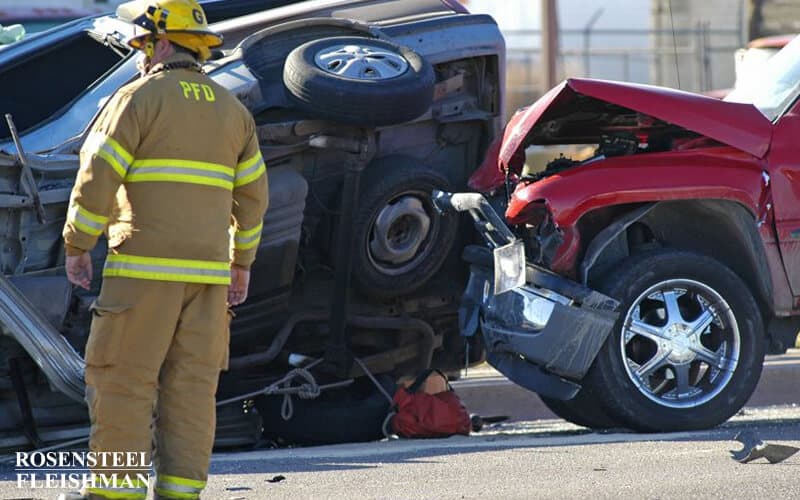After a serious accident, life can feel unfamiliar and overwhelming. When paralysis is involved, the impact often reaches far beyond the initial injury and brings a mix of physical challenges, emotional stress, and everyday uncertainty. Many people are unsure of what to do next or how to protect their future. Talking with a car accident […]

Florida Bear Involved in Car Accident Which Killed Three People
Last night, in Florida, a black bear was involved in a car accident which killed three people. A woman driving an SUV hit the 300-pound black bear on a dark, remote road in the Everglades. A passing car with three people stopped to help the woman in the SUV. After the second car stopped to help, a third car came along the road and hit the SUV and the three people from the second car. Sadly, all three people from the second car died. Eight other people were injured in the accident. The bear also died in the accident.
This is an unusual accident because it involved a bear, but this type of scenario could happen more commonly with another animal like a deer. In a situation like this one in North Carolina, how would we assess liability for the damages suffered?
An injured person in a car accident wishing to collect damages must show that another party was negligent. To prove negligence, the injured party must show that (1) the other party had a duty to exercise reasonable care, (2) the other party breached that duty, (3) the injured party suffered injuries, and (4) the breach of the duty was both the proximate and actual cause of the injuries.
There are not many details given in the article explaining why the woman in the SUV hit the bear or why the third car hit the SUV. We do know from the report that the road on which this tragic accident occurred was “dark” and “remote.” We might imagine that the bear ran out into the road suddenly and the SUV could not avoid it, and the third car did not see the SUV stopped in the road in sufficient time to avoid it because of the dark road conditions. Does this relieve the SUV driver and the driver of the third car from liability?
First, let’s consider a statement from the North Carolina Court of Appeals case, Holbrook v. Henley (1995):
As a general rule, every motorist driving upon the highways of this state is bound to a minimal duty of care to keep a reasonable and proper lookout in the direction of travel and see what he ought to see.
This duty would not require a driver to anticipate that a bear might run across the road in front of her car, even in dark, remote conditions. In fact, the only one who could hold the SUV driver liable for failing to see the bear would be the bear himself, who obviously cannot bring a claim for damages.
The driver of the third car might be potentially negligent, however. We do not know whether this driver was traveling above the speed limit or if he was momentarily inattentive, but if either of these factors was present, the driver of the third car might be negligent because he had a duty to keep a “proper lookout in the direction of travel and see what he ought to see.” If he was unable to stop before hitting the stopped SUV because he breached this duty, he might be liable for the injuries suffered.
However, the driver of the third car can raise a couple of defenses. The first would be contributory negligence. In most states, a plaintiff’s negligence will reduce the amount of damages he can recover, but North Carolina is one of a handful of jurisdictions that follow the stricter rule of contributory negligence. A plaintiff’s contributory negligence can completely bar his recovery of damages.
The driver of the third car might argue that it was contributory negligence for the injured people to be in the middle of the road. Pedestrians have a duty to exercise reasonable care as well as motorists. This duty might be breached if a pedestrian fails to keep a lookout for cars before crossing the street. The situation described in the CNN report is slightly different than your average pedestrian crossing the street, however. First, it is not entirely clear from the report that they were in the road at all, since the third car first hit the SUV and then hit the three people. Second, they were in the roadway area not to cross the street but to provide assistance to the SUV driver involved in the initial accident with the bear. It seems that it would be difficult to show contributory negligence based on the few facts given in the report.
Next, let’s consider the SUV driver’s contributory negligence. We might assume that the SUV was left in the middle of the road following the initial accident with the bear. North Carolina statute G.S. 20-161 provides that
No person shall park or leave standing any vehicle, whether attended or unattended, upon the main-traveled portion of any highway or highway bridge with the speed limit posted less than 45 miles per hour unless the vehicle is disabled to such an extent that it is impossible to avoid stopping and temporarily leaving the vehicle upon the paved or main traveled portion of the highway or highway bridge.
If the SUV driver failed to comply with this statute, she would be negligent per se and only proximate cause would have to be proven to show the contributory negligence of the SUV driver. However, after colliding with a 300-pound bear, it is likely that the SUV was “disabled to such an extent that it [was]impossible to avoid stopping and temporarily leaving the vehicle” as provided in the exception to the requirement of the statute.
The driver of the third car might also argue that he is not liable under the sudden emergency doctrine. The court of appeals summarized the sudden emergency doctrine as follows in Holbrook:
An automobile driver, who, by the negligence of another and not his own negligence, is suddenly placed in an emergency and compelled to act instantly to avoid a collision or injury, is not guilty of negligence if he makes such a choice as a person of ordinary prudence placed in such a position might make, even though he made neither the wisest choice nor the one that would have been required in the exercise of ordinary care except for the emergency.
However, the sudden emergency doctrine does not relieve a motorist from liability when the emergency is caused in whole or in part by the motorist’s own negligent. Therefore, if the driver of the third car should have seen the stopped SUV with the exercise of due care, he would not be successful in raising the sudden emergency doctrine as a defense.
If you have been injured in a car accident, visit www.rflaw.net for legal help.
Additional Car Accident Articles
After a crash, it is completely normal to feel overwhelmed. Many people are unsure about what to do next, especially when insurance companies begin asking questions that feel rushed or confusing. The process can feel even more stressful when you are dealing with pain, vehicle damage, or worry about missing work. Having the right support […]
Back injuries after a crash can leave anyone feeling unsettled, especially when the pain is not immediately obvious. Many people walk away thinking they are fine, only to realize days later that something feels off. That sense of uncertainty can make the entire situation even more stressful, particularly when you are trying to manage work, […]
After a car accident, many people feel unsure about what to do next, especially when injuries start affecting daily life. It is common to feel overwhelmed by medical appointments, insurance calls, and the overall strain the situation creates. When everything feels uncertain, having the support of a car accident law firm in Charlotte can make […]
